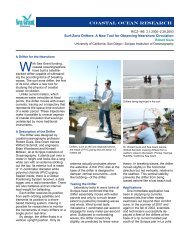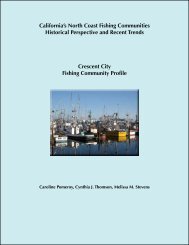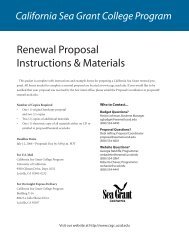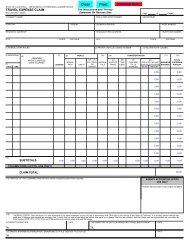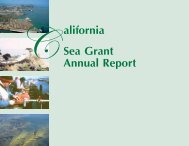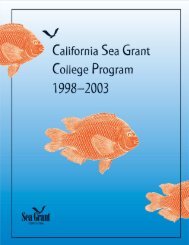California's Central Coast Marine Protected Areas - California Sea ...
California's Central Coast Marine Protected Areas - California Sea ...
California's Central Coast Marine Protected Areas - California Sea ...
You also want an ePaper? Increase the reach of your titles
YUMPU automatically turns print PDFs into web optimized ePapers that Google loves.
Site 1: Simple topography<br />
Species richness = 77<br />
Turf Weed<br />
<strong>Sea</strong>grass<br />
Coralline Algae<br />
Irridescent <strong>Sea</strong>weed<br />
Mussels<br />
Tide Pool<br />
Offshore<br />
Site 2: Complex topography<br />
Species richness = 97<br />
not being harvested,”<br />
he says.<br />
Mussels are important to<br />
intertidal ecology because<br />
so many other species<br />
live within and on top of<br />
them, while owl limpets<br />
are crucial because<br />
they maintain territories,<br />
thereby preventing other<br />
species from dominating<br />
all areas. Raimondi calls<br />
both “foundation<br />
species.”<br />
Ecological Zones<br />
In terms of conceptualizing the ecology of the rocky intertidal,<br />
Raimondi divides the <strong>Central</strong> <strong>Coast</strong> Study Region into<br />
three distinct zones: one from Point Conception to Cayucos,<br />
another from Cayucos to Monterey, and the last from Santa<br />
Cruz to Pigeon Point.<br />
Point Conception to Cayucos<br />
The conspicuous absence of black abalone, historically the<br />
region’s most abundant herbivore, defines the southernmost<br />
zone, Raimondi says. “Black abalone have crashed<br />
and are verging on extinction in their southern range,”<br />
he says, largely because of the abalone wasting disease<br />
known as withering syndrome.<br />
The loss of abalone has had profound consequences for<br />
community structure and diversity. “For the most part, in<br />
places without black abalone, there is an overgrowth of<br />
sessile invertebrates (sponges and tunicates), barnacles<br />
and algae,” he says.<br />
Cayucos to Monterey<br />
While the absence of black abalone defines the southern<br />
zone, the reappearance of these mollusks defines<br />
the middle one, as Cayucos marks the northern limit of<br />
the withering syndrome epidemics that wiped out black<br />
abalone populations to the south.“We see large populations<br />
of black abalone beginning at about Cayucos,” Raimondi<br />
says. “The problem is you have a lot of poaching.”<br />
Big Sur’s igneous and metamorphic geology, and its inaccessibility,<br />
also distinguish this region.<br />
“We see more owl limpets, mussels and black abalone, and<br />
they are much bigger (older) in Big Sur because they are<br />
Inshore<br />
Scientists created 3-D models of the topography and species diversity that will be useful<br />
in monitoring changes over time.<br />
Pete Raimondi, UC Santa Cruz<br />
Santa Cruz to<br />
Pigeon Point<br />
To a large extent, sand and<br />
its scouring action over<br />
rocky habitat shape the<br />
biogeography of this zone.<br />
Sand covers much of the<br />
coastline from Monterey<br />
to Santa Cruz, Raimondi<br />
explains. In northern Santa Cruz, the geology changes and<br />
sedimentary rocks dominate. Visitors see this manifested in<br />
the region’s many pocket beaches and partially sand-covered<br />
rocky ledges.<br />
“This is a very dynamic zone because of the seasonal sand<br />
scour and build up,” Raimondi says. Summer swells can<br />
pile up 3 meters of sand onto beaches in a couple days. One<br />
winter swell can take it all away.Only some species (notably<br />
algae) can tolerate this level of sand scour and disturbance.<br />
“The region is its own little biologically distinct community,”<br />
Raimondi says.<br />
Conclusions<br />
In this project, scientists identified outstanding characteristics<br />
and differences among the sites surveyed, located<br />
hotspots of biodiversity, and showed that MPAs protect<br />
parts of all these important areas. They also identified three<br />
biogeographical zones within the central coast that they<br />
expect will respond uniquely to the MPAs. Much of the Big<br />
Sur coast, for example, has been a de facto reserve and<br />
so may not change much in the future. In other areas, the<br />
creation of the MPAs might actually lead to more human<br />
visitors to the coast. This may exacerbate ecological degradation<br />
from trampling, litter and poaching and create a need<br />
for more monitoring and public education about the fragile<br />
nature of many coastal resources..<br />
Contact:<br />
Pete Raimondi<br />
UC Santa Cruz<br />
831.459.5674<br />
raimondi@biology.ucsc.edu



